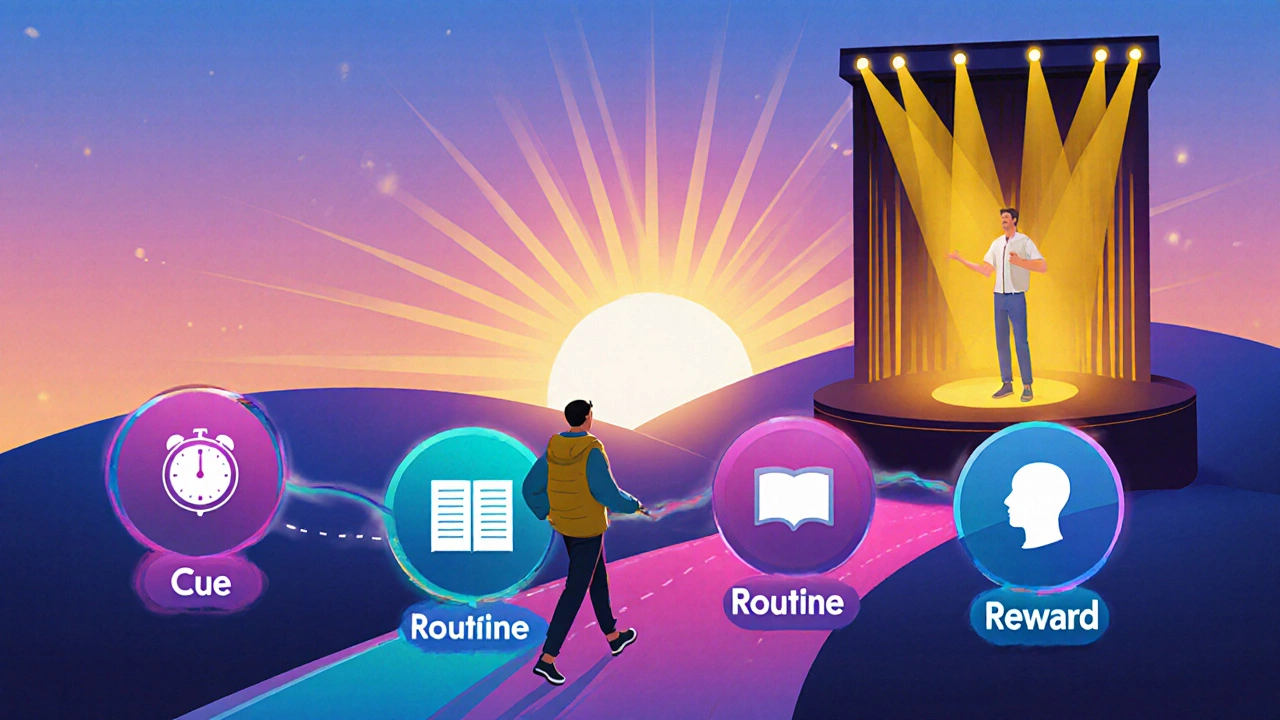Mindset Habit Builder
Your Personalized Mindset Plan
Create a 5-step daily routine based on your goals and preferences
Your Personalized Plan
Step 1: Define Your Goal
Step 2: Select Technique
Step 3: Set Cue
Step 4: Schedule
Step 5: Track Progress
Use the daily log below to track your practice
Daily Log
Key Takeaways
- Mindset training is a systematic practice that rewires thought patterns for better performance.
- Core principles rely on neuroplasticity, self‑talk control, and habit loops.
- Simple exercises-visualization, affirmations, mental rehearsal-can be done in minutes each day.
- Applications span sports, business, education, and everyday personal goals.
- A clear 5‑step plan helps you start and stay consistent.
When you hear the phrase mindset training, you might picture a motivational speaker or a self‑help book. In reality, it’s a concrete set of techniques that trains your brain to adopt more productive, resilient habits. Below we break down what mindset training really is, why it works, and how you can put it into practice right now.
Mindset training is a structured approach to reshaping mental habits, using evidence‑based exercises that target thought patterns, emotional responses, and behavioral routines. It draws from neuroscience, sports psychology, and cognitive behavioral methods to create lasting change. By repeatedly practicing specific mental drills, you harness the brain’s natural ability to rewire itself-known as neuroplasticity-and replace limiting beliefs with empowering ones.
Core Principles Behind Mindset Training
Three scientific pillars support any effective mindset‑training program:
- Neuroplasticity: The brain continuously forms new neural pathways based on experience. Repeated mental exercises strengthen desired pathways and prune the unhelpful ones.
- Self‑talk management: The internal dialogue drives emotional states. By consciously shaping self‑talk, you steer reactions toward confidence rather than fear.
- Habit loop engineering: Every habit follows a cue‑routine‑reward cycle. Mindset training rewrites the routine component to embed positive mental habits.
These principles intersect with the concept of a growth mindset-the belief that abilities can be developed through effort. While a growth mindset is a mental attitude, mindset training provides the actionable drills that turn that attitude into a habit.

Key Techniques & Everyday Exercises
Below are the most common drills used by athletes, CEOs, and students alike. You can mix and match based on your goals.
- Visualization (Mental Rehearsal): Spend 2‑3 minutes daily picturing yourself performing a target activity flawlessly. Engage all senses-what do you see, hear, feel? This primes neural circuits as if you’d already done it.
Example: A public speaker visualizes stepping onto the stage, hearing applause, and delivering each slide with confidence.
- Affirmation Statements: Craft short, present‑tense statements that reflect the mindset you want. Repeat them aloud or silently during a break.
Example: “I handle challenges with calm focus.” Say this three times before a tough meeting.
- Thought‑Record Journaling (borrowed from Cognitive Behavioral Therapy): Write down a triggering event, the automatic thought, the emotional reaction, and an alternative, balanced thought.
Example: Trigger - missed deadline; Automatic thought - “I’m a failure”; Alternative - “One slip doesn’t define my competence; I’ll adjust my plan.”
- Micro‑Goal Setting: Break a big objective into bite‑size tasks that can be completed in under 30 minutes. Celebrate each mini‑win to reinforce the habit loop.
- Breathing Reset: When anxiety spikes, practice the 4‑7‑8 breath (inhale 4 sec, hold 7 sec, exhale 8 sec). This physiological cue reduces cortisol and clears mental chatter.
Mindset Training vs. Related Practices
It’s easy to mix up mindset training with other self‑development tools. The table below highlights the main differences.
| Aspect | Mindset Training | Growth Mindset | Cognitive Behavioral Therapy (CBT) | Performance Coaching |
|---|---|---|---|---|
| Primary Goal | Build repeatable mental habits | Adopt belief that abilities can improve | Alleviate psychological distress | Optimize specific performance outcomes |
| Typical Tools | Visualization, affirmations, habit loops | Mindset framing, reflection | Thought records, exposure exercises | Feedback loops, KPI tracking |
| Duration | Ongoing, daily practice | Long‑term attitude shift | Therapeutic course (weeks‑months) | Project‑based, often short‑term |
| Evidence Base | Neuroscience, sport psychology | Educational research | Clinical psychology trials | Business performance studies |
Real‑World Applications
Mindset training isn’t just theory; it shows measurable gains across many fields.
- Sports: Olympic swimmers use daily visualization to perfect stroke timing, reporting up to a 3% improvement in race split times.
- Business: A fintech startup implemented a 10‑minute affirmation routine before each sprint planning meeting. Velocity rose by 12% over three months.
- Education: High‑school students who practiced a 5‑minute thought‑record exercise before exams showed a 7‑point boost in average scores.
- Personal health: Individuals who paired habit‑loop breathing resets with nightly journaling lost an average of 4lb in six weeks, attributing success to reduced emotional eating.

Designing Your Own Mindset Training Plan
Follow this five‑step checklist to create a habit‑forming routine that sticks.
- Define a clear outcome: What specific result do you want? Example - “Speak confidently in a 10‑minute presentation.”
- Select 2‑3 core techniques: Pair visualization with an affirmation statement that aligns with the outcome.
- Set cue triggers: Choose moments that reliably signal practice time (e.g., after brushing teeth or before lunch).
- Schedule micro‑sessions: Commit to 5 minutes per cue, using a timer to stay honest.
- Track progress: Use a simple log - date, technique, perceived confidence level (1‑10). Review weekly to adjust.
Consistency beats intensity. Even a modest 5‑minute daily habit compounds into noticeable mental agility over weeks.
Common Pitfalls and Pro Tips
- Skipping the cue - Without a reliable trigger, the routine collapses. Tie the practice to an already‑stamped habit like coffee brewing.
- Vague affirmations - “I’m better” is too fuzzy. Make them specific and present: “I deliver clear, confident ideas.”
- Over‑complicating the plan - Start with one technique. Add more only after the first habit feels automatic.
- Ignoring feedback - Periodically assess whether the mental drills translate into real‑world performance. Adjust cues or language as needed.
Pro tip: Pair each mental drill with a physical anchor - a fist‑clench, a foot‑tap, or a posture change. The body cue reinforces the brain pathway.
Frequently Asked Questions
How long does it take to see results from mindset training?
Most people notice subtle shifts in confidence and focus within 2‑4 weeks of consistent daily practice. Tangible performance gains (e.g., better sales numbers or faster race times) usually emerge after 6‑8 weeks, because neural pathways need repeated activation to solidify.
Is mindset training the same as meditation?
They overlap but aren’t identical. Meditation mainly cultivates present‑moment awareness and reduces stress, while mindset training is goal‑oriented, using specific visualizations, affirmations, and habit‑loop restructuring to achieve a desired performance outcome.
Can I combine mindset training with therapy?
Absolutely. Techniques from Cognitive Behavioral Therapy like thought records complement mindset drills. If you’re dealing with deep‑seated anxiety or trauma, consult a licensed therapist and treat mindset training as a supplemental performance tool.
Do I need special equipment for visualization?
No gear required. A quiet corner, closed eyes, and a timer work fine. Some people like a vision board or a phone app that plays subtle background music to enhance sensory immersion, but those are optional.
What’s the best time of day to practice?
Choose moments when your mind is naturally alert but not overstressed. Many users find early‑morning (after waking) or post‑workout (when neurochemicals are primed) ideal. Consistency matters more than exact timing.






